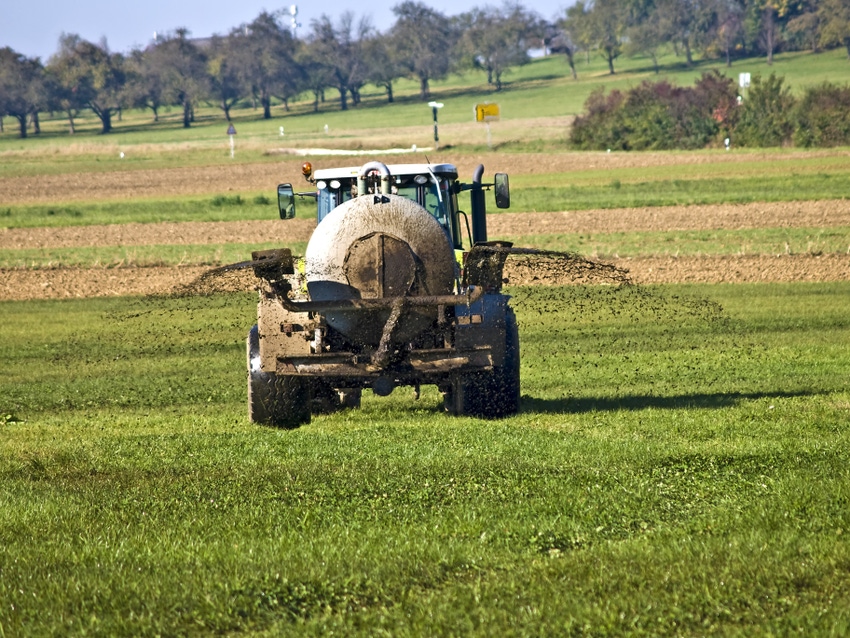Online tool helps farmers time manure applications with weather
National Weather Service provides data and guidance to states to create similar tools in Michigan, Ohio and Wisconsin.

The Minnesota Department of Agriculture (MDA) recently announced that it has teamed up with the National Oceanic & Atmospheric Administration's (NOAA) National Weather Service to design a tool that helps farmers and commercial applicators determine the best time to apply manure.
The Runoff Risk Advisory Forecast tool uses past and predicted National Weather Service (NWS) weather data, such as precipitation, temperature and snow melt, to predict the likelihood that applied manure will run off fields in daily, next-day and 72-hour increments, MDA said. Farmers and commercial applicators can use an interactive map to locate their field and find the forecasted risk. Users can also sign up for email or text messages for their county that alert them to a severe runoff risk for that day.
“By providing this information, we hope to give our farmers and commercial manure applicators the tools they need to make well-informed decisions,” Minnesota agriculture commissioner Dave Frederickson said. “By being able to better predict times of high runoff risk, we can decrease the potential loss of manure to our waterways and increase farm productivity by saving nutrients on the land. It is a win-win situation based on an easy-to-use tool.”
The interactive map displays the runoff risk in one of four categories: no runoff expected, low, moderate or severe. When the risk is moderate or severe, MDA recommends that the applicator evaluate the situation to determine if there are other locations or later dates when the manure application could take place.
MDA said the forecasting tool can also be used by others looking for climate information, including 2 in. soil depth temperatures that are useful at planting time and 6 in. soil depth temperatures that are helpful when determining fall fertilizer application in appropriate areas.
The Minnesota Runoff Risk Advisory Forecast is part of a larger federal project. NWS has provided data and guidance to states for the purpose of creating similar tools in Michigan, Ohio and Wisconsin. In Minnesota, state funding for the project was provided by the Clean Water, Land & Legacy Amendment.
Other Great Lake states
Launched in 2017, the Michigan State University (MSU) EnviroImpact Tool was designed to help all Michigan livestock producers work to improve water quality.
The Michigan effort was a partnership among NWS, the Michigan Department of Agriculture & Rural Development (MDARD), the Michigan Agriculture Environmental Assurance Program, the MSU Institute of Water Research, Michigan Sea Grant and MSU Extension.
The MSU EnviroImpact Tool provides maps showing short-term runoff risks for daily manure application planning purposes — taking into account factors such as precipitation, temperature, soil moisture and landscape characteristics. Farmers handling and applying livestock manure in Michigan can use this tool during any time of year to determine how risky it will be to spread manure on their fields.
“The MSU EnviroImpact Tool, jointly funded by MSU and MDARD, provides the latest technology in weather forecasting at the fingertips of Michigan farmers,” MSU Extension Agriculture & Agribusiness Institute director Dr. Ronald Bates said. “This online, mobile-friendly tool helps farmers assess their risk of possible runoff as they develop their manure spreading schedules. Farmers have the ability to adjust their management plans if a rainfall event on particular fields is imminent, enabling them to make better management decisions and improve their ability to protect Michigan’s water quality.”
According to MDARD, the Runoff Risk Decision Support tools are unique examples of collaboration between federal and state agencies, universities and the agricultural industry to develop real-time tools and provide guidance to help address the issue of nutrient application timing.
“NOAA and the NWS are excited to be an integral partner with the Great Lakes states in the development of runoff risk tools for agriculture producers and nutrient applicators,” said Steve Buan, NOAA hydrologist in charge. “Effective collaboration among the partners has resulted in the validation of NOAA/NWS environmental forecast capabilities with on-farm research gathered across the region. Adoption of this runoff risk tool in Michigan, as well as the other Great Lakes states, will result in both economic savings for producers as well as improved water quality from the local level all the way to the Great Lakes.”
While the purpose of this tool is to help reduce the risk of applied manure leaving agricultural fields, it is very important that farmers also follow Manure Management Plans and assess the risk for each field prior to manure applications, MDARD said.
Those interested in viewing or using the MSU EnviroImpact Tool can visit enviroimpact.iwr.msu.edu.
The Ohio Department of Agriculture (ODA) also introduced its nutrient management tool in 2017. The Ohio Applicator Forecast is an online tool designed to help nutrient applicators identify times when the potential nutrient loss from a fertilizer or manure application is low.
“ODA firmly believes science and technology must be at the forefront of all water quality issues and these new and innovative tools are impactful steps that will merge the ideas of precision farming and precision conservation,” ODA director David T. Daniels said in announcing the tool last year. “The agricultural community continues to take the necessary steps to maintain agricultural productivity while protecting our natural resources and reducing nutrient runoff to improve water quality in Lake Erie and surrounding waterways.”
For the Ohio Applicator Forecast, visit http://agri.ohio.gov/divs/plant/OhioApplicatorForecast/oaf.aspx.
The Wisconsin online tool is available at http://www.manureadvisorysystem.wi.gov/app/runoffrisk.
About the Author(s)
You May Also Like



